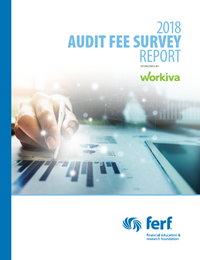
©NicoElNino/ISTOCK/THINKSTOCK
Senior-level financial executives saw an increase in audit fees in the latest reporting year as the result of new accounting standards, particularly for revenue and leases, according to the 2018 Audit Fee Survey report by Financial Education & Research Foundation (FERF) released today.
In addition to the new accounting rules, executives that took part in the survey cited higher merger and acquisition activity and Public Company Accounting Oversight Board (PCAOB) inspection reports and staff alerts pushing audits costs higher.
“We’re seeing a large increase in documentation requests, such as documenting the process management goes through to come to its conclusions,” says one controller in an interview included in the. “That increases the time it takes to complete and document [an] audit.”
 According to the survey, public companies are reporting a median increase of 2.5 percent for their 2017 audits. Similarly, private companies reported a median increase of 3.2 percent, and nonprofit organizations reported flat fees.
According to the survey, public companies are reporting a median increase of 2.5 percent for their 2017 audits. Similarly, private companies reported a median increase of 3.2 percent, and nonprofit organizations reported flat fees.
The increases reported in the survey, sponsored by Workiva, compare with a median increase of 1.3 percent for public companies last year. Reported increases were 3.7 percent for private companies and 1.6 percent for nonprofits.
According to an analysis of 6,340 public companies by financial analysis firm idaciti, SEC registrants reported a median fee increase of 5.7 percent for their 2017 audits.
Despite these potential challenges for preparers, auditors say the marketplace is stable and competitive, with clients demanding greater efficiency during the audit process.
“All our audit committees and senior executives are having that discussion with their auditors and saying, ‘What can we do to get through this in a more efficient way, whether it’s your technology or leveraging the work of others, or both?’” says EisnerAmper partner Jerry Ravi.
Automation Increasing
Automation is continuing its expansion in the core operations of finance teams interested in increasing their effectiveness and efficiency. Primarily among larger organizations, tools such as robotic process automation (RPA) and artificial intelligence (AI) are starting to help finance teams increase efficiency and enhance their internal controls.
Companies are automating basic functions such as balance sheet reconciliation as well as moving data automatically between systems instead of pasting data manually into spreadsheets. Other functions suitable to artificial intelligence include identifying patterns that would otherwise be invisible to a human, or compiling data from several sources as part of the financial close.
A controller in the financial services industry expects automation to increase his company’s audit fees in the short term as the technology is validated, before leading to longer-term cost reductions.
“In many ways, cost-effectiveness is going to come once the technology reaches a steady state. I’m of the view that in the year you put a lot of robotics in, the firms may actually have more to audit as they get comfortable with an automated accounting environment. It becomes an efficiency play after that.”
Mitigation Strategies
One of the key ways respondents say they’re mitigating audit fee increases is devoting more time and effort to audit planning. This can mean sitting down with the audit team immediately after a prior-year audit closes to discuss what worked and what could have gone better, as well as reviewing scoping documents for the coming year closely to understand the factors that can drive fees or having more information ready before the auditors show up to begin their field work.
Another common strategy several respondents cite is expanding internal staffs or enlisting other resources to take on work they formerly relied on their auditors to perform. For instance, a financial industry preparer says his organization has assumed 500 to 700 hours of work using a combination of team members and interns to perform audit-related work.
“We’ve told them, we’ll take on everything that they’re willing to give us,” he says. “I’ve told our CFO that if they’re willing to give us more, and I can’t accommodate it, it’s cheaper for us to hire additional people than it is to pay them.”
“If there’s an analysis they’re interested in, such as revenue or AP fluctuations, we now do that for them,” says an energy sector chief accounting officer. “We take their templates and give them the information the way they want it, so they have to do very little work….We try to use their same sample methodology and sizes so we can eliminate their work.”
Respondents also cite the importance of meeting regularly with auditors, usually at least quarterly, to update them on planned or recent organizational developments, discuss potential issues, and resolve any questions outside of the year-end rush. Discussing each party’s contributions to the process and understanding each other’s expectations can reduce confusion and the amount of work that needs to be reverified or repeated.